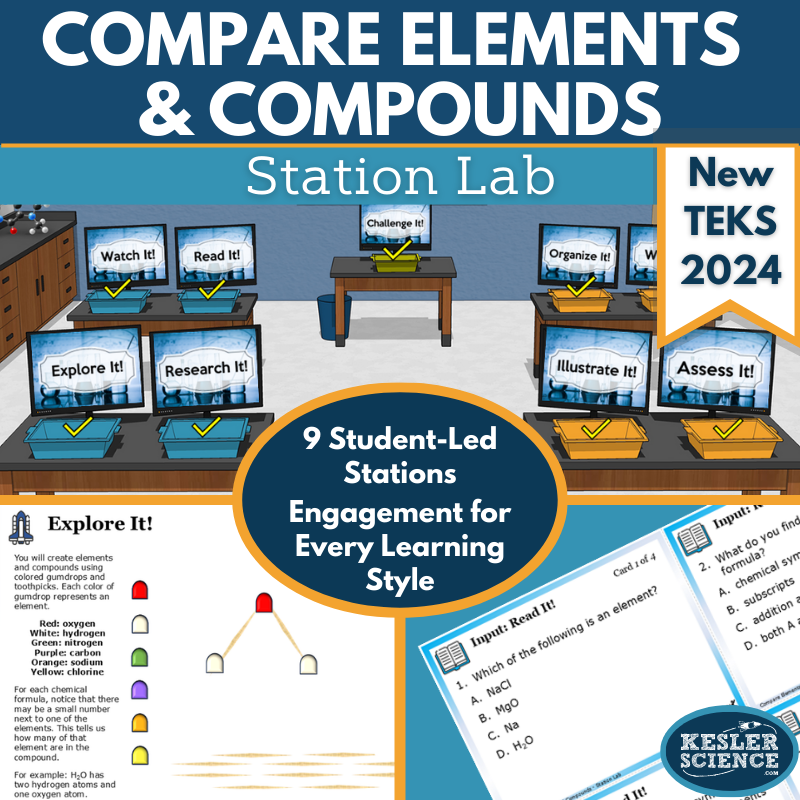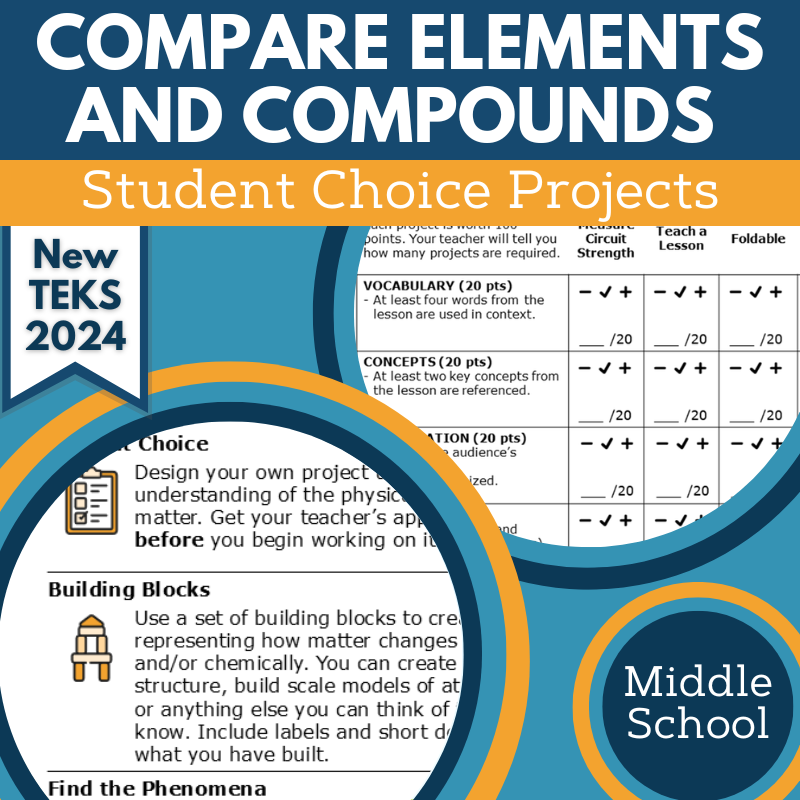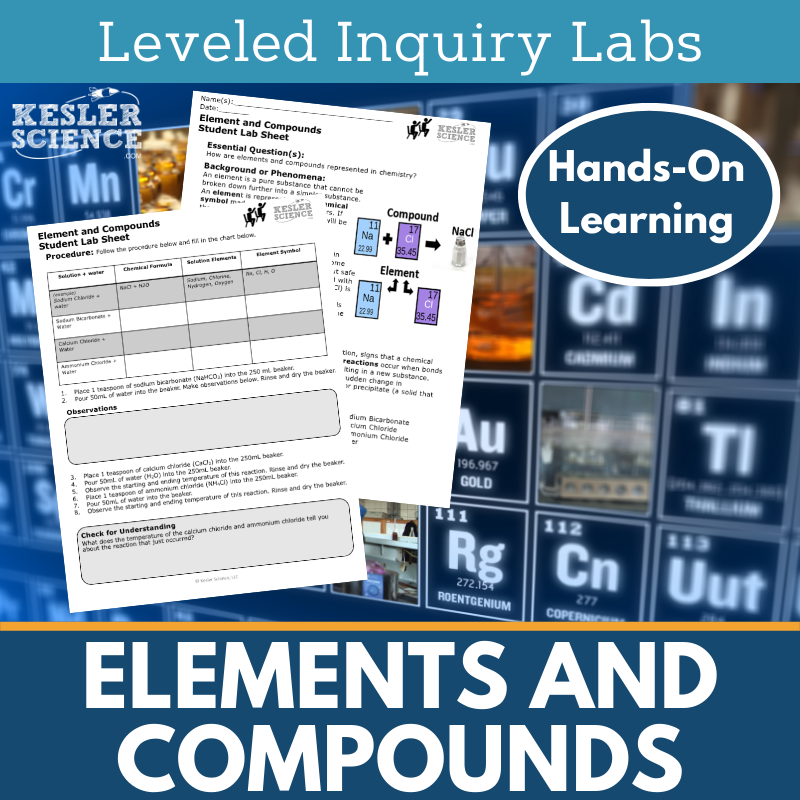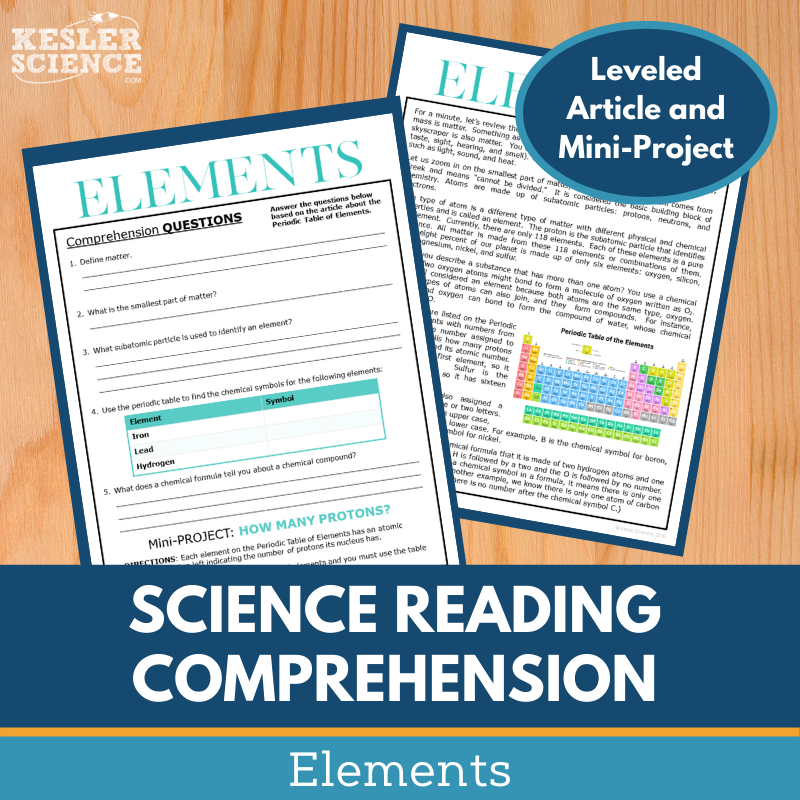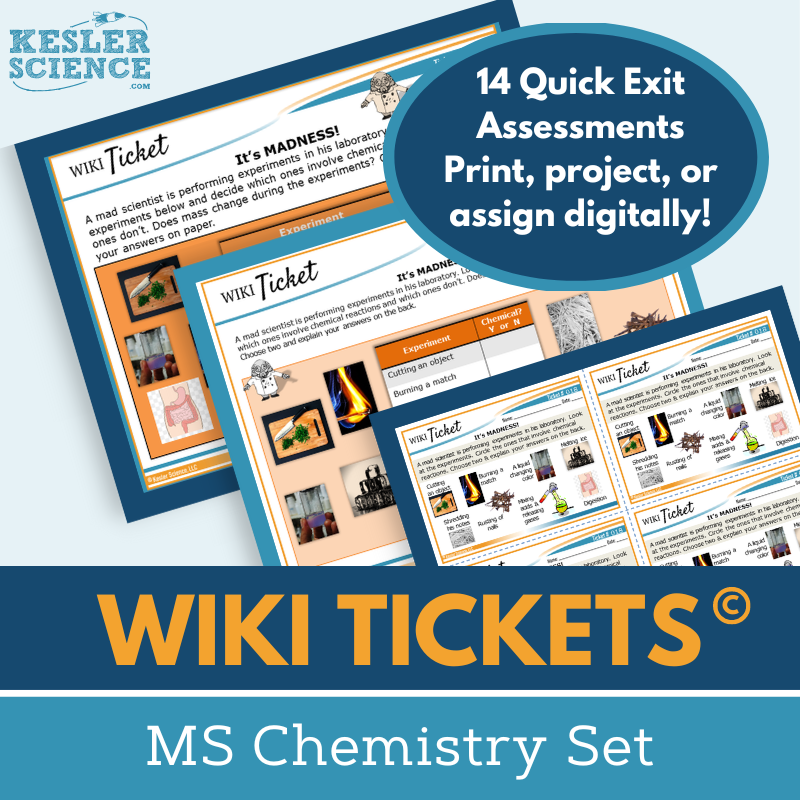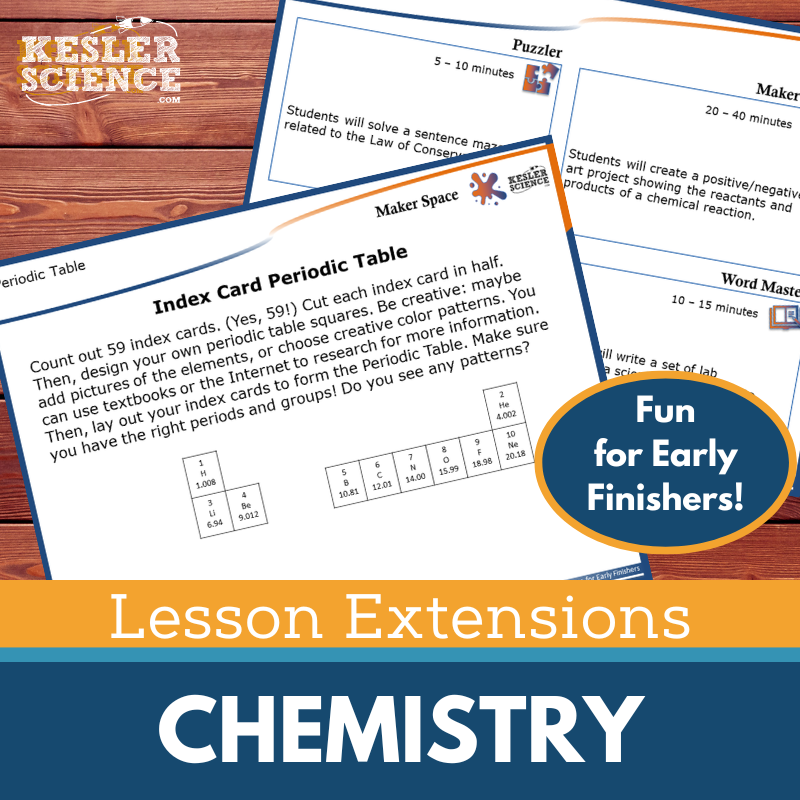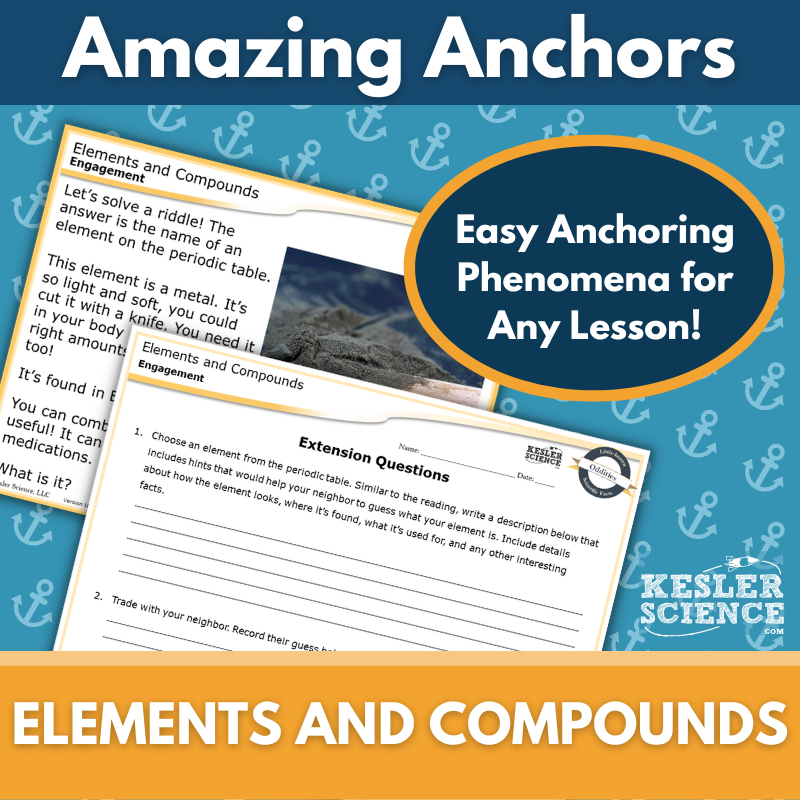Compare Elements & Compounds Activities for Middle School Science
Distinguishing between elements and compounds is a key concept in chemistry, and these engaging resources help middle school students master it with ease! The resources below will give students a comprehensive understanding of elements and compounds. All of the following materials are also included in the Kesler Science Membership.
The Elements and Compounds 5E Lesson provides middle school students with an engaging, hands-on approach to understanding the differences between elements and compounds through atoms, molecules, chemical symbols, and formulas. Aligned with TEKS 7.6A, this fully editable, low-prep unit includes PowerPoints, worksheets, choice projects, and assessments to support student-led learning in both digital and print formats.
Using the 5E Model, students will explore key concepts through interactive station labs, multimedia resources, and structured note-taking templates. Hands-on investigations, videos, research tasks, and comprehension activities help students develop a deeper understanding of how matter is classified and represented. Student-choice projects allow for creative applications, while STAAR 2.0-aligned assessments provide opportunities for review and mastery.
Perfect for in-person and virtual learning, this highly flexible resource allows teachers to tailor instruction to different learning styles. Whether used as a standalone lesson or part of a broader chemistry curriculum, this lesson ensures students build a strong foundation in chemistry while staying engaged in the learning process.
The Elements and Compounds 5E Lesson provides middle school students with an engaging, hands-on approach to understanding the differences between elements and compounds through atoms, molecules, chemical symbols, and formulas. Aligned with TEKS 7.6A, this fully editable, low-prep unit includes PowerPoints, worksheets, choice projects, and assessments to support student-led learning in both digital and print formats.
Using the 5E Model, students will explore key concepts through interactive station labs, multimedia resources, and structured note-taking templates. Hands-on investigations, videos, research tasks, and comprehension activities help students develop a deeper understanding of how matter is classified and represented. Student-choice projects allow for creative applications, while STAAR 2.0-aligned assessments provide opportunities for review and mastery.
Perfect for in-person and virtual learning, this highly flexible resource allows teachers to tailor instruction to different learning styles. Whether used as a standalone lesson or part of a broader chemistry curriculum, this lesson ensures students build a strong foundation in chemistry while staying engaged in the learning process.
The Compare Elements & Compounds Station Lab, aligned with TEKS 7.6A, provides a hands-on, student-led learning experience that helps middle school students differentiate between elements and compounds using atoms, molecules, chemical symbols, and formulas. This modular and flexible resource allows students to engage with interactive, multimodal stations, reinforcing key chemistry concepts in an engaging and independent way.
With nine differentiated stations, students explore the topic through hands-on experiments, videos, research, and reading passages, then demonstrate their understanding by organizing information, illustrating models, writing responses, and completing assessments. The Challenge It! station provides extension activities for early finishers, while differentiated reading passages in English and Spanish ensure accessibility for all learners.
Designed for both in-person and virtual learning, this low-prep, high-engagement resource includes printable and digital formats available in PowerPoint and Google Slides. Whether used as a standalone activity or part of the Chemistry Station Lab Bundle (15 topics), this station lab fosters critical thinking and deeper comprehension of how elements and compounds are classified and represented in chemistry.
The Compare Elements & Compounds Station Lab, aligned with TEKS 7.6A, provides a hands-on, student-led learning experience that helps middle school students differentiate between elements and compounds using atoms, molecules, chemical symbols, and formulas. This modular and flexible resource allows students to engage with interactive, multimodal stations, reinforcing key chemistry concepts in an engaging and independent way.
With nine differentiated stations, students explore the topic through hands-on experiments, videos, research, and reading passages, then demonstrate their understanding by organizing information, illustrating models, writing responses, and completing assessments. The Challenge It! station provides extension activities for early finishers, while differentiated reading passages in English and Spanish ensure accessibility for all learners.
Designed for both in-person and virtual learning, this low-prep, high-engagement resource includes printable and digital formats available in PowerPoint and Google Slides. Whether used as a standalone activity or part of the Chemistry Station Lab Bundle (15 topics), this station lab fosters critical thinking and deeper comprehension of how elements and compounds are classified and represented in chemistry.
The Compare Elements & Compounds Student Choice Projects, aligned with TEKS 7.6A, give students the freedom to showcase their understanding in a way that suits their learning style. With six creative project options plus a “design your own” choice, students explore atoms, molecules, chemical symbols, and formulas through engaging, personalized activities. A flexible, editable rubric allows for teacher, peer, or self-assessment, making grading simple.
This differentiated resource includes two versions of the project page—one with modified options for extra support and another for students ready for an additional challenge. Teachers can customize the rubric to align with their grading needs, making this a versatile and easy-to-use tool.
Perfect for in-class or digital learning, these projects use common classroom supplies or digital tools for completion. Also available in the Chemistry Student Choice Project Bundle (15 topics) and the MEGA Bundle (84 topics), this resource provides an engaging way to reinforce key chemistry concepts while promoting independent learning.
The Compare Elements & Compounds Student Choice Projects, aligned with TEKS 7.6A, give students the freedom to showcase their understanding in a way that suits their learning style. With six creative project options plus a “design your own” choice, students explore atoms, molecules, chemical symbols, and formulas through engaging, personalized activities. A flexible, editable rubric allows for teacher, peer, or self-assessment, making grading simple.
This differentiated resource includes two versions of the project page—one with modified options for extra support and another for students ready for an additional challenge. Teachers can customize the rubric to align with their grading needs, making this a versatile and easy-to-use tool.
Perfect for in-class or digital learning, these projects use common classroom supplies or digital tools for completion. Also available in the Chemistry Student Choice Project Bundle (15 topics) and the MEGA Bundle (84 topics), this resource provides an engaging way to reinforce key chemistry concepts while promoting independent learning.
This resource includes three differentiated lab versions to support all learners:
Dependent Lab – Guided procedures with structured inquiry questions.
Modified Lab – Simplified steps and built-in support, including sentence stems and multiple-choice options.
Independent Lab – A more open-ended experience where students take charge of their investigation.
With editable teacher materials, answer keys, and CER (Claim, Evidence, and Reasoning) reflection questions, this lab encourages scientific reasoning and problem-solving. Using common lab materials, students will actively engage with real-world chemistry applications in a low-prep, high-impact format. Available as a standalone resource or part of the Complete Inquiry Labs Bundle, this lesson provides a dynamic way to explore chemical composition and reactions.
Engage students in hands-on investigations to explore the differences between elements and compounds with the Compare Elements & Compounds Inquiry Lab, aligned with TEKS. Students will analyze chemical formulas, observe compounds in reactions, and identify the elements that make up different substances to deepen their understanding of how matter is classified.
This resource includes three differentiated lab versions to support all learners:
Dependent Lab – Guided procedures with structured inquiry questions.
Modified Lab – Simplified steps and built-in support, including sentence stems and multiple-choice options.
Independent Lab – A more open-ended experience where students take charge of their investigation.
With editable teacher materials, answer keys, and CER (Claim, Evidence, and Reasoning) reflection questions, this lab encourages scientific reasoning and problem-solving. Using common lab materials, students will actively engage with real-world chemistry applications in a low-prep, high-impact format. Available as a standalone resource or part of the Complete Inquiry Labs Bundle, this lesson provides a dynamic way to explore chemical composition and reactions.
The Compare Elements & Compounds Science Reading Comprehension Lesson, aligned with TEKS, helps students explore how elements and compounds are classified through an engaging nonfiction article. Students will learn that elements are pure substances represented by chemical symbols and compounds are pure substances represented by chemical formulas, then apply their understanding by identifying the number of protons in an element based on its atomic number.
This resource includes two Lexile-leveled passages (1100-1300) to support differentiation, along with 5-7 comprehension questions and a hands-on mini-project to reinforce learning. A Cornell notes template is provided to guide structured reading, and colorful graphics enhance engagement (while remaining printable in grayscale).
Perfect for sub plans, extra credit, ISS, or whole-class instruction, this print and digital-friendly resource integrates seamlessly with Google Classroom, MS Teams, Schoology, and Canvas. Whether used for building science literacy, classroom discussions, or independent practice, this lesson strengthens students’ ability to analyze scientific texts and apply chemistry concepts in a meaningful way.
The Compare Elements & Compounds Science Reading Comprehension Lesson, aligned with TEKS, helps students explore how elements and compounds are classified through an engaging nonfiction article. Students will learn that elements are pure substances represented by chemical symbols and compounds are pure substances represented by chemical formulas, then apply their understanding by identifying the number of protons in an element based on its atomic number.
This resource includes two Lexile-leveled passages (1100-1300) to support differentiation, along with 5-7 comprehension questions and a hands-on mini-project to reinforce learning. A Cornell notes template is provided to guide structured reading, and colorful graphics enhance engagement (while remaining printable in grayscale).
Perfect for sub plans, extra credit, ISS, or whole-class instruction, this print and digital-friendly resource integrates seamlessly with Google Classroom, MS Teams, Schoology, and Canvas. Whether used for building science literacy, classroom discussions, or independent practice, this lesson strengthens students’ ability to analyze scientific texts and apply chemistry concepts in a meaningful way.
The Elements and Compounds Science Writing Prompt Activity, aligned with TEKS, brings chemistry to life by challenging students to create a skit or drama that explores chemical symbols, formulas, atoms, and molecules. This engaging, low-prep activity encourages students to apply their science knowledge in a fun and creative way, reinforcing key concepts through storytelling and performance.
This resource includes projection-ready prompts, full- and half-sheet handouts, rubrics, and teacher directions, as well as a digital version for Google Slides and PowerPoint. It’s perfect for whole-class collaboration, independent projects, or small group activities, making it a great fit for formative assessments, student-choice projects, or extra credit opportunities.
Designed for in-person and virtual learning, students can perform their skits, write scripts, or compile their work into a class anthology. Whether used for review, early finishers, or cross-curricular integration, this writing prompt offers a unique and interactive way to reinforce science literacy and chemistry concepts. Also available in the Science Writing Prompt Activities Bundle, this resource adds creativity to your middle school science curriculum!
The Elements and Compounds Science Writing Prompt Activity, aligned with TEKS, brings chemistry to life by challenging students to create a skit or drama that explores chemical symbols, formulas, atoms, and molecules. This engaging, low-prep activity encourages students to apply their science knowledge in a fun and creative way, reinforcing key concepts through storytelling and performance.
This resource includes projection-ready prompts, full- and half-sheet handouts, rubrics, and teacher directions, as well as a digital version for Google Slides and PowerPoint. It’s perfect for whole-class collaboration, independent projects, or small group activities, making it a great fit for formative assessments, student-choice projects, or extra credit opportunities.
Designed for in-person and virtual learning, students can perform their skits, write scripts, or compile their work into a class anthology. Whether used for review, early finishers, or cross-curricular integration, this writing prompt offers a unique and interactive way to reinforce science literacy and chemistry concepts. Also available in the Science Writing Prompt Activities Bundle, this resource adds creativity to your middle school science curriculum!
The Compare Elements & Compounds WIKI Tickets© Formative Assessments, aligned with TEKS, provide a quick and engaging way to check student understanding of atoms, molecules, chemical symbols, and formulas. These assessments help students compare and contrast elements and compounds while reinforcing key chemistry concepts in a fun, interactive format.
Each WIKI Ticket© set includes five flexible formats: a full-screen projection version, three printable handout sizes (full, split, and quarter-page), and a digital interactive version for Google Slides or PowerPoint. Designed for exit tickets, bellringers, or quick progress checks, these assessments give teachers an efficient way to gauge student learning in real time.
Perfect for both in-person and virtual learning, students can complete their responses digitally or on paper. Whether used for daily review, formative assessment, or class discussions, these low-prep, high-impact WIKI Tickets© help students solidify their understanding of how elements and compounds are classified and represented in chemistry.
The Compare Elements & Compounds WIKI Tickets© Formative Assessments, aligned with TEKS, provide a quick and engaging way to check student understanding of atoms, molecules, chemical symbols, and formulas. These assessments help students compare and contrast elements and compounds while reinforcing key chemistry concepts in a fun, interactive format.
Each WIKI Ticket© set includes five flexible formats: a full-screen projection version, three printable handout sizes (full, split, and quarter-page), and a digital interactive version for Google Slides or PowerPoint. Designed for exit tickets, bellringers, or quick progress checks, these assessments give teachers an efficient way to gauge student learning in real time.
Perfect for both in-person and virtual learning, students can complete their responses digitally or on paper. Whether used for daily review, formative assessment, or class discussions, these low-prep, high-impact WIKI Tickets© help students solidify their understanding of how elements and compounds are classified and represented in chemistry.
The Compare Elements & Compounds Lesson Extensions, aligned with TEKS, offer engaging, student-driven activities that push learning beyond the basics. Designed to challenge early finishers and promote deeper thinking, these extensions provide interactive and creative opportunities to explore atoms, molecules, chemical symbols, and formulas in new ways.
Each lesson extension includes four distinct activities:
Puzzler – Strengthens problem-solving with chemistry-based challenges.
Maker Space – Encourages hands-on exploration through a creative, STEAM-focused task.
Tech Connection – Integrates digital tools to reinforce student learning.
Word Master – Engages students in science-based writing and communication.
With teacher directions, answer keys, printable handouts, and digital projection options, this low-prep resource is ideal for lesson wrap-ups, enrichment, or filling unplanned downtime. Whether used individually or as a set, these activities keep students actively engaged while reinforcing essential chemistry concepts.
The Compare Elements & Compounds Lesson Extensions, aligned with TEKS, offer engaging, student-driven activities that push learning beyond the basics. Designed to challenge early finishers and promote deeper thinking, these extensions provide interactive and creative opportunities to explore atoms, molecules, chemical symbols, and formulas in new ways.
Each lesson extension includes four distinct activities:
Puzzler – Strengthens problem-solving with chemistry-based challenges.
Maker Space – Encourages hands-on exploration through a creative, STEAM-focused task.
Tech Connection – Integrates digital tools to reinforce student learning.
Word Master – Engages students in science-based writing and communication.
With teacher directions, answer keys, printable handouts, and digital projection options, this low-prep resource is ideal for lesson wrap-ups, enrichment, or filling unplanned downtime. Whether used individually or as a set, these activities keep students actively engaged while reinforcing essential chemistry concepts.
Introduce students to the world of chemistry through an intriguing real-world mystery with the Compare Elements & Compounds Amazing Anchors Phenomenon Lesson, aligned with TEKS. This two-part resource bookends any lesson on elements and compounds, sparking curiosity and reinforcing key concepts through engaging, structured readings.
Students begin with an introductory reading about a mysterious element, using comprehension and extension questions to build anticipation and set the stage for deeper learning. The second reading breaks down the science behind potassium, explaining what makes it an element in a clear and accessible way. Additional reinforcement questions help solidify student understanding.
This no-prep resource includes teacher directions, answer keys, full-page projection slides, and both print and digital formats for use with Google Classroom, MS Teams, and other LMS platforms. A modified version with sentence starters and differentiated language supports all learners, making this an excellent introductory or follow-up activity that encourages students to think critically about the classification of matter in the real world.
Introduce students to the world of chemistry through an intriguing real-world mystery with the Compare Elements & Compounds Amazing Anchors Phenomenon Lesson, aligned with TEKS. This two-part resource bookends any lesson on elements and compounds, sparking curiosity and reinforcing key concepts through engaging, structured readings.
Students begin with an introductory reading about a mysterious element, using comprehension and extension questions to build anticipation and set the stage for deeper learning. The second reading breaks down the science behind potassium, explaining what makes it an element in a clear and accessible way. Additional reinforcement questions help solidify student understanding.
This no-prep resource includes teacher directions, answer keys, full-page projection slides, and both print and digital formats for use with Google Classroom, MS Teams, and other LMS platforms. A modified version with sentence starters and differentiated language supports all learners, making this an excellent introductory or follow-up activity that encourages students to think critically about the classification of matter in the real world.
Year-Round Resources
These year-round activities will increase your students' understanding of many middle school science topics. All of these activities are also included in the Kesler Science Membership.
Visual Data & Graphing
You're not alone if your students struggle with understanding graphs, charts, and tables. It's a skill that takes an enormous amount of practice. This resource will help students build a strong foundation in analyzing data and creating their own data visualizations.
Bell Ringers and Warm-Ups
These middle school science bell ringers are an excellent way to engage your students as soon as they walk into your classroom. This comprehensive FULL YEAR resource includes everything you need to start off each science class with an interesting warm-up activity.
Review Board Games
Each game board has been carefully designed to keep students engaged. There are 10 different action spaces on each board and dozens of question cards. All of the actions are related to science concepts and keep the students motivated throughout the game.
Each game is ready to play. Simply print out the board and the cards and let the students enjoy reviewing nine different units.
Essential Questions and Standards
Below are the essential questions and standards associated with the lessons and activities included in the atoms unit. This topic is only one of more than 100 middle school science topics included in the Kesler Science Membership.
-
How can we compare and contrast elements and compounds?
-
How do atoms, molecules, chemical symbols, and chemical formulas help us distinguish elements and compounds?
-
TEKS Science - 7.6A Compare Elements & Compounds
Kesler Science Membership
Imagine never having to search for another middle school science lesson again. The membership gives you access to ALL of the Kesler Science products in one place (Yes, including everything above).
Say goodbye to long hours of lesson prep.



